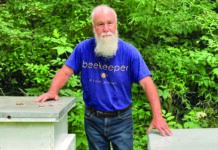Description: Green June beetle larvae are cream-colored grubs from ¼-inch to two-inches in length depending on the stage of molting. The adult beetle is almost one-inch long with a velvety-green, oval-shaped body. The edges of the body are orange-yellow and the wing covers are reddish-brown. The eggs are round and about 1/16-inch in diameter.
Life Cycle: There is one generation of green June beetles per year. The grubs that hatch from eggs in the fall overwinter in the soil in cases they create from the soil and a substance that excretes from their body. In the spring the grubs pupate and the adult beetles develop in two to three weeks. The beetles emerge from the soil in late June through July to mate. Females then lay eggs in clusters of 10 to 30 eggs. The eggs hatch within two weeks.
Damage: Larvae feed on decaying organic matter as well as roots. As the grubs tunnel below the ground they can cause damage to lawns by feeding on the roots as well as pushing soil up through the tunnel holes creating small mounds of dirt at the surface. Larvae may also feed on underground vegetables such as sweet potatoes and carrots. Adult beetles may skeletonize leaves primarily of fruit trees but also oaks and maples. They can also eat the fruit on the trees.
Control: Many general-use insecticides, including carbaryl (Sevin dust) and malathion, may be used to discourage feeding. Follow insecticide label instructions for application rates and waiting period between application and harvest. For some crops carbaryl products have a longer waiting period than malathion and vise versa so choose your product accordingly.
Cynthia Domenghini, Extension Agent




